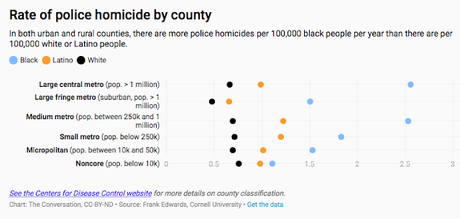

Too many Whites in America are still denying that we have a problem with police violence in this country -- especially violence toward Black men. Consider this article by Frank Edwards (Cornell University) and Michael H. Esposito (University of Washington).
Police in the U.S. kill on average more than 1,000 men per year, or about three men per day. According to our estimates, police are responsible for about 8 percent of all adult male homicide deaths in the U.S. each year. These estimates come from our study, published on July 19. We relied on novel unofficial data collected through Fatal Encounters, a systematic review of media and public records searches by researchers and journalists. Our team of sociologists with expertise on race and health, which includes Hedwig Lee at Washington University in St. Louis, used these new data to estimate Americans’ underlying risk. Our analysis shows that risk of police-involved death is two times higher than indicated by official data sources. Police in the U.S. kill on average more than 1,000 men per year, or about three men per day. According to our estimates, police are responsible for about 8 percent of all adult male homicide deaths in the U.S. each year. These estimates come from our study, published on July 19. We relied on novel unofficial data collected through Fatal Encounters, a systematic review of media and public records searches by researchers and journalists. Our team of sociologists with expertise on race and health, which includes Hedwig Lee at Washington University in St. Louis, used these new data to estimate Americans’ underlying risk. Our analysis shows that risk of police-involved death is two times higher than indicated by official data sources. Journalists, academics and activists have started independent data collection efforts to meet the shortcomings of federal data on police-involved deaths. Projects like Fatal Encounters, which leverages public records and media coverage in an attempt to document every person killed in an interaction with police, have made it possible to speak more precisely about the nature of police-involved deaths in the U.S. These data allow researchers, for the first time, to reliably measure how often individuals die in interactions with the police and quantify racial and regional differences. We used Fatal Encounters’ records of police killings documented between 2012 and 2018 to provide a new set of estimates for all U.S. counties by race. Fatal Encounters documented 9,795 police-involved deaths during this period. Men comprised 88 percent of the deaths. After excluding cases in which police use of force was not the direct cause of death – generally suicides and vehicular collisions – we identified 6,295 adult male victims of police homicide killed over this six-year period, or about 1,000 per year. By contrast, the National Vital Statistics System and the Arrest Related Deaths program record about 500 deaths per year, less than half of our count. We used Fatal Encounters’ records of police killings documented between 2012 and 2018 to provide a new set of estimates for all U.S. counties by race. Fatal Encounters documented 9,795 police-involved deaths during this period. Men comprised 88 percent of the deaths. After excluding cases in which police use of force was not the direct cause of death – generally suicides and vehicular collisions – we identified 6,295 adult male victims of police homicide killed over this six-year period, or about 1,000 per year. By contrast, the National Vital Statistics System and the Arrest Related Deaths program record about 500 deaths per year, less than half of our count. Our analysis shows that about 0.7 white men per 100,000 are killed by police annually. Latino and black men are killed at higher rates, at about one death per 100,000 men and 2.2 deaths per 100,000 men per year, respectively. This means that black men are, on average, three times more likely to be killed by police than are white men. Latino men’s risk of being killed by police is about 40 percent higher than the risk faced by white men. The inequalities we found in the likelihood of being killed by police are similar to previously published estimates using official data, though we estimate the rates of police homicide are about twice as high as prior estimates. Racial differences in risk vary across U.S. states. Black men face the highest risk of being killed by police in Oklahoma, while Latino risk is highest in New Mexico. White risk is also exceptionally high in Oklahoma. Though men are around 10 times more likely to be killed by police than are women, racial inequality in risk extends across gender. Using these same data, we estimate that black women and American Indian and Alaska Native woman are at much higher risk of being killed by police than are white women. Studies show that incarceration harms individual and community health and is a key driver of inequality in the U.S. Aggressive stop-and-frisk style policing is linked to increased anxiety and post-traumatic symptoms among young men. Our research adds to the increasing scholarly consensus that the U.S. criminal justice system is a key social determinant of health. Our study indicates that contact between civilians and law enforcement exposes individuals to a nontrivial risk of premature death.

